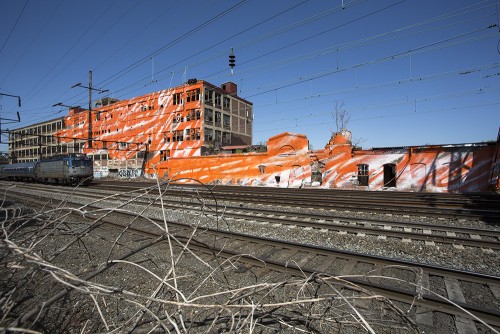We have the money and the know how to tackle most of our social problems. Certainly unemployment, houselessness, and poverty. So, why don’t we?
In large part it is because our socially created wealth remains outside social control. Critical economic decisions are driven by private interests not the public good. One result is hipster economics.
If you are not familiar with the concept, I recommend Sarah Kendzior’s The Perils of Hipster Economics. Here is the first part:
On May 16, an artist, a railway service and a government agency spent $291,978 to block poverty from the public eye.
Called psychylustro, German artist Katharina Grosse’s project is a large-scale work designed to distract Amtrak train riders from the dilapidated buildings and fallen factories of north Philadelphia. The city has a 28 percent poverty rate – the highest of any major U.S. city – with much of it concentrated in the north. In some north Philadelphia elementary schools, nearly every child is living below the poverty line.
Grosse partnered with the National Endowment of the Arts and Amtrak to mask North Philadelphia’s hardship with a delightful view. The Wall Street Journal calls this “Fighting Urban Blight With Art.” Liz Thomas, the curator of the project, calls it “an experience that asks people to think about this space that they hurtle through every day.”
The project is not actually fighting blight, of course – only the ability of Amtrak customers to see it.

“I need the brilliance of colour to get close to people, to stir up a sense of life experience and heighten their sense of presence,” Grosse proclaims.
“People,” in Grosse and Thomas’s formulation, are not those who actually live in north Philadelphia and bear the brunt of its burdens. “People” are those who can afford to view poverty through the lens of aesthetics as they pass it by.
Urban decay becomes a set piece to be remodeled or romanticised.
The rest of the article is here.
Martin Hart-Landsberg is a professor of economics at Lewis and Clark College. You can follow him at Reports from the Economic Front.
Comments 18
NancyP — June 11, 2014
The price tag is too high. However, I do see the value of enabling community artists to design and paint murals on subjects they choose (well, barring crotch shots). Given the segregated nature of poor neighborhoods, "pride" murals are common: portraits of MLK and other national luminaries , portraits of local civil rights heroes, black inventors and their inventions, etc. The murals don't get tagged, so they must be acceptable to the community.
Yrro Simyarin — June 11, 2014
"We have the money and the know how to tackle most of our social problems. Certainly unemployment, houselessness, and poverty."
That's one of the boldest claims I've heard in a while :)
Agreed that we probably could have made better progress on those issues than this art project, though.
Andrew — June 11, 2014
A few thoughts.
1. $292,000 is a lot of money, but it's actually a relatively low budget for a major public art installation, and drastically less than permanent monuments. Additionally, the sources of funding - which include both private contributions and grants from the National Endowment for the Arts and the Pew Center for Arts & Heritage - are all extracted from budgets that aren't in any way earmarked for anti-poverty programs. By emphasizing the price, this article creates the mistaken impression that funds that could have been allocated for poverty relief were somehow diverted to art.
2. Poverty is not an architectural aesthetic. It's a condition of the human experience. It's not the sight of a bunch of dilapidated buildings (which many people find quite beautiful); it's the agony of having to live in one. It would be extremely naive to think that looking at a bunch of decaying factories from a train window would somehow enlighten wealthy commuters about the state of a neighborhood and inspire greater empathy with its residents. Therefore, the idea that these paintings somehow "hide" poverty is also suspect. The audience is already well aware of why they didn't choose to live in this neighborhood.
3. I'm disturbed to see the term "Hipster" thrown about so casually in a sociological context. What does the word actually communicate, aside from its user's derisiveness? White people who can't afford to live in Manhattan? Young people with middle-class backgrounds and tenuous job prospects? Or just whatever outsiders the speaker doesn't like? As a student, I would have been harshly scolded for using a loaded stereotypical term like that without qualifying its demographic parameters. To see a journalist and an economic professor doing that very thing not so many years later is depressing.
4. An art project that actually aimed to improve the quality of life for people living in the neighborhood (rather than those just passing through it) would probably be a less controversial use of the funds. But a dearth of colorful art is the least of Philadelphia's worries - and indeed, urban art is alive and well in our poorest neighborhoods, and indifferent to the whims of the NEA.
global local — June 11, 2014
I think that it is not so much about hiding poverty, as commodifying it. The project description says: "The ever-evolving city is the canvas and your window is the frame." The experience of the commuter is enhanced by the literal painting over the landscape. Inequality and poverty served up for consumption. Not unrelated to the role of artists in gentrification.
http://boundariesandborders.tumblr.com/post/88399570479/artists-working-to-make-poverty-a-spectacle-to-consume